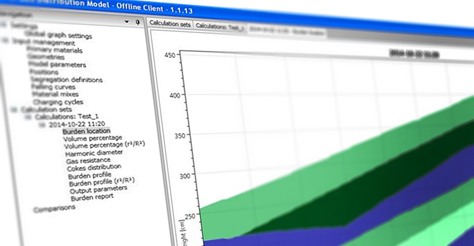-
Mathematical models steer the blast furnaces
In the blast furnace, iron ore is melted into hot metal. For the steering and optimisation of the blast furnace process, ArcelorMittal Gent utilises mathematical models. These enable us to continuously have a detailed view on the blast furnace process thus easily giving us the possibility to re-direct where needed.

The mystery behind the blast furnace
The blast furnace is a chemical reactor. The transformation of iron ore into hot metal, is conducted under extremely high temperatures, with massive pressure and it takes place in an environment containing a lot of CO gas. This is why, in the blast furnace itself, it is almost impossible to conduct a lot of readings. We thus have to rely on mathematical models.
Mathematical models add clarity
We utilise three types of models:
- Models that, on a short term, allow us to measure the thermal condition of the blast furnace.
- Models that provide a more detailed image of the processes taking place within the blast furnace, allowing us to utilise the installation on a longer timeframe.
- Classification algorithms, allowing us to interpret and follow-up on the available data.
Models for the thermal condition
For a good performance of the blast furnace, we must maintain a constant temperature of the hot metal. This might seem easy to establish by measuring the temperature and controlling the energy supply. However, the blast furnace process goes slowly. Merely heating up the massive amount of material until it reaches the right temperature, can take up to a couple of hours.
Thanks to mathematical models, we are now able to get rid of this delay. By analysing the composition of the gas, which leaves the blast furnace on top, we can define the chemical reactions which are taking place at that exact time in the blast furnace. And, as every reaction utilises a certain amount of energy, the operator is always able to add the correct amount of energy needed.
Models for optimisation with a longer timeframe
It is not sufficient to merely control the blast furnace on a thermal level. Due to everlasting changing conditions (for example the fluctuations in the quality of raw materials), we also need to adjust additional parameters to maintain the optimum working point. To do this, our process engineers utilise different models. They, for instance, use a thermal-chemical model of the blast furnace, that models the entire flow of gas as well as the main blast furnac’ reactions. This offers us a rather complete image of the inside of the blast furnace, only by monitoring the edge.
Classification algorithms for following-up the data
In a few cases, the number of measure points available is so high, that we are obliged to use models which divide the data into different classes. An example of this technique is the Self Organising Map. This can be used to follow-up on the evolution of multi-dimensional measurements over a longer period of time. This is how, for instance, we follow–up on the evolution of the temperature profile of the blast furnace.
-
More process innovation


